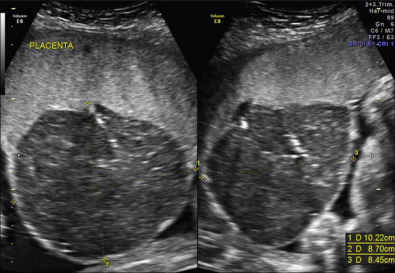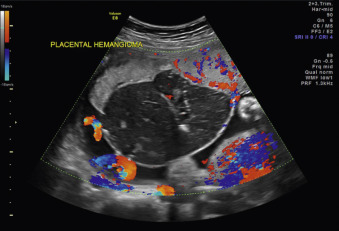Abstract
Chorioangiomas are the most common type of placental tumor and are found in 0.5%-1% of placentas examined at delivery. They are formed by excessive proliferation of blood vessels in the chorionic villi and are perfused by the fetal circulation. On ultrasound, they appear as well-circumscribed, hypoechoic lesions when compared with the surrounding placental tissue. Adverse outcomes, including fetal growth restriction, polyhydramnios, and placental abruption, can be seen in chorioangiomas larger than 4-5 cm, warranting close surveillance with the larger lesions.
Keywords
placenta, chorioangioma, therapy, laser, ultrasound, Doppler
Disease
Prevalence and Epidemiology
Chorioangiomas are found in 0.5% to 1% of placentas examined at delivery. Microangiomas are the most common but are less likely to cause any fetal or maternal complications and will often go undetected. Masses greater than 5 cm, also known as larger or giant chorioangiomas, however, are found in 1 : 10,000 to 3 : 10,000 pregnancies.
Etiology and Pathophysiology
Histologically, there are two main types of chorioangiomas: angiomatous (formed from numerous blood vessels), and cellular (formed by loose mesenchymal tissue). Large tumors often contain degenerative changes such as necrosis, calcification, and myxoid changes. They are formed by excessive proliferation of blood vessels in chorionic villi and are perfused by the fetal circulation. The size, therefore, determines the amount of fetal blood that is sequestered within the tumor and increases the risk for fetal complications.
Manifestations of Disease
Clinical Presentation
Chorioangiomas over 4–5 cm in maximum diameter, or multiple smaller chorioangiomas, have been associated with adverse perinatal outcomes, including intrauterine growth restriction, polyhydramnios leading to preterm labor and preterm delivery, and placental abruption. Fetal complications include high-output failure, thrombocytopenia due to platelet sequestration, fetomaternal hemorrhage, disseminated intravascular coagulopathy, and potentially, fetal or neonatal demise.
Imaging Techniques and Findings
Ultrasound.
Most chorioangiomas are small, intraplacental, singular tumors, and are often not identified on ultrasound (US) as they do not cause any complications. In addition, it is difficult to differentiate these tumors from other placental lesions. They generally can appear as well-circumscribed, hypoechoic lesions compared to the surrounding placental tissue ( Fig. 99.1 ). Large tumors can be of variable shapes and can contain fibrous septae. The use of Doppler is helpful in the evaluation since this is a vascular lesion with prominent blood flow ( Fig. 99.2 ). It can also estimate the degree of vascularity as increased vascularity would increase the risk for fetal complications. This may help in differentiating it from a hematoma or fibrin collection that would not have any significant blood flow. Prapas et al. retrospectively reviewed cases of a suspected chorioangioma over a 9-year period. As the grayscale appearance of a chorioangioma is indistinguishable from placental hemorrhage, they confirmed the utility of color flow mapping and pulsed Doppler for diagnosis. In addition, color Doppler imaging can also confirm vascular channels that are continuous with the fetal circulation, ruling out other diagnoses such as degenerated myoma, placental teratoma, or incomplete hydatidiform mole. Previous research has shown the benefit of color Doppler for identifying a discrete “feeding vessel,” especially in cases when prenatal therapy is being considered.












